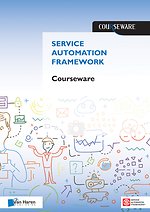Service Automation Framework
For the Design and Delivery of Automated Services (PDF-Download)
E-book Pdf met watermerkbeveiliging Engels 2017 1e druk 9789401802086Samenvatting
Service Automation is the concept of achieving customer loyalty by the use of automated technologies and builds upon a large demographic and sociological trend. We are the self-service generation, who are able to make our own decisions. The self-service generation is nowadays used to search, evaluate and purchase products online for a number of years now.
This book will give you deep insight into the concept of Service Automation, the concept by which you can automate customer service in your organization. If you adequately apply Service Automation in your organization, you will see both employee and customer satisfaction rise and significantly increase the number of people who 'like' your company.
The Service Automation Framework (SAF®) has been created to find a methodical way to discuss Service Automation. It offers a simplistic version of any organization, which includes a number of processes that every organization can think of to systematically enhance its Service. As with any model, it is a simplified version of reality, but it structures the mind and provides uniform terminology when discussing the contents with co-workers and colleagues. Nothing more, nothing less. We encourage you to adapt and apply the model in any way that you see fit and which helps you and your organization.
This book is intended for anyone who has ever experienced that the level of Service in his organization can be increased and is looking for guidance on a step-by-step model to achieve this, whether you are an entrepreneur, executive, consultant or work in the field of academia.
Trefwoorden
Specificaties
Lezersrecensies
Inhoudsopgave
1. WHY SERVICE AUTOMATION?
1.1 Introduction
1.2 Target audience
1.3 Service Automation Qualifi cations
2. HISTORY OF AUTOMATION
2.1 Introduction
2.2 A brief history of automation
2.3 A brief overview of the future
3. THE SERVICE AUTOMATION FRAMEWORK
3.1 Introduction
3.2 Service Automation strategy
3.3 Business drivers for Service Automation
3.4 The defi nition of Service
3.5 The service concept
3.6 The defi nition of Service Automation
3.7 The Service Automation Framework
3.8 Design elements and processes
3.9 Service Automation implementation
3.10 Organizing for Service Automation
SECTION 2; A DEEP DIVE INTO THE HEART OF THE SERVICE AUTOMATION FRAMEWORK
4. THE USER: WELCOME THE SELF-SERVICE GENERATION
4.1 Introduction
4.2 First things fi rst: users and customers
4.3 The self-service generation
4.4 From consumer experience to user experience
4.5 User Experience
4.6 User Groups and User Characteristics
4.7 Translating User Profi les into User Actions
4.8 Summary
5. SERVICE DESIGN: BUILDING THE SERVICE AUTOMATION BLUEPRINT
5.1 Introduction
5.2 A short history of Service Design
5.3 Service Design concepts and terminology
5.4 The Service Automation Blueprint
5.5 Composing a Service Automation Blueprint
5.6 The Service Automation Blueprint Canvas in practice
5.7 Summary
6. TECHNOLOGY: THE SELF-SERVICE INTERFACE
6.1 Introduction
6.2 A brief history of Service Automation technology
6.3 Technology drivers for Service Automation
6.4 Self-Service Portals
6.5 Types of Self-Service Portals
6.6 Technology Interface Modeling
6.7 Summary
SECTION 3: A DEEP DIVE INTO THE BRAIN OF THE SERVICE AUTOMATION FRAMEWORK
7. AUTOMATED DEPLOYMENT: SCALING SERVICES
7.1 Introduction
7.2 The process nature of service
7.3 Process Automation
7.4 Process cluster I – Automated Deployment
7.5 The Provisioning Process
7.6 The Familiarization Process
7.7 The Fulfi llment Process
7.8 Automated Deployment in practice
7.9 Summary
8. SERVICE DELIVERY AUTOMATION: AUTOMATED SUPPORT SERVICES
8.1 Introduction
8.2 Scenario Analysis
8.3 Process cluster II - Service Delivery Automation
8.4 The Request Process
8.5 The Inquiry Process
8.6 The Resolution Process
8.7 The Upgrade Process
8.8 The Feedback Process
8.9 Service Delivery Automation in practice
8.10 Summary
9. SERENDIPITY: TRANSFORMING CUSTOMERS INTO FANS
9.1 Introduction
9.2 Transforming customers into fans
9.3 The business case for Serendipity Management
9.4 Process cluster III – Serendipity Management
9.5 The Serendipity Process
9.6 Serendipity Management in practice
9.7 Summary
SECTION 4: ADDITIONAL MATERIALS
Appendix A - Additional Materials
Appendix B - End notes
Acknowledgement
Index
Vaak samen gekocht
Vergelijkbare boeken
Anderen die dit e-book kochten, kochten ook
Rubrieken
- advisering
- algemeen management
- coaching en trainen
- communicatie en media
- economie
- financieel management
- inkoop en logistiek
- internet en social media
- it-management / ict
- juridisch
- leiderschap
- marketing
- mens en maatschappij
- non-profit
- ondernemen
- organisatiekunde
- personal finance
- personeelsmanagement
- persoonlijke effectiviteit
- projectmanagement
- psychologie
- reclame en verkoop
- strategisch management
- verandermanagement
- werk en loopbaan

















